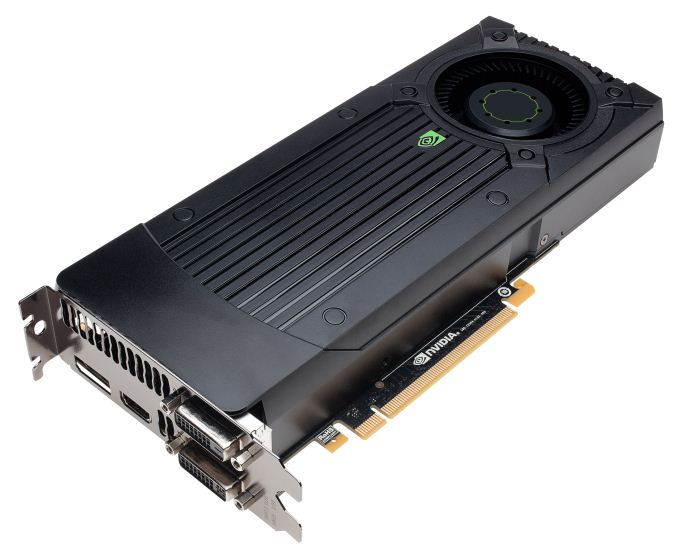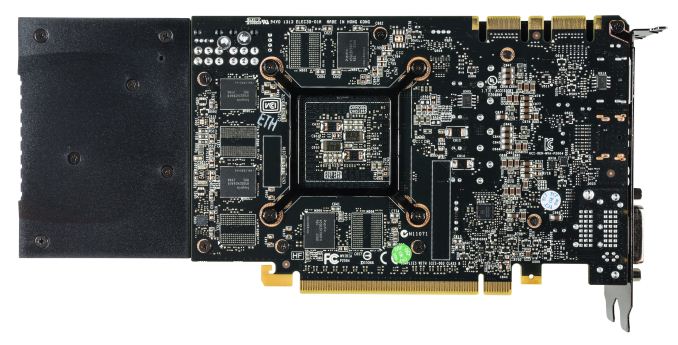NVIDIA GeForce GTX 760 Review: The New Enthusiast Kepler
by Ryan Smith on June 25, 2013 9:00 AM ESTMeet the GeForce GTX 760
As we mentioned earlier, due to its 170W TDP the GTX 760 is essentially a drop-in replacement for the GTX 670 in board designs. Even NVIDIA’s reference design reflects this, with the reference GTX 760 being based on the reference GTX 670’s cooler and PCB. Consequently there’s not much to say about the GTX 760’s design that we haven’t said before. If you’ve seen a GTX 670 then you’ve seen a GTX 760, down to the last screw. For consistency we’ll quickly go over the GTX 760’s design, but this is generally a rehash of what we’ve already said about the GTX 670.
Like GTX 670 before it, GTX 760 is another “small” GK104 design. The complete card is 9.5” long, however the actual PCB is far shorter at only 6.75” long, 3.75” shorter than the GTX 770’s PCB. In fact it would be fair to say that rather than strapping a cooler onto a card, NVIDIA strapped a card onto a cooler. Meanwhile we see that once again NVIDIA is using Hynix R0C (6GHz) GDDR5 RAM here.
The cooler itself is fairly simple, utilizing an aluminum heatsink melded with a copper base plate. A separate heatsink covers the VRM circuitry – once again mounted at the front of the card – while the fan hangs off of the rear of the card. This unfortunately is the same fan as on the GTX 670, which means it makes a faint grinding sound at low RPMs. This design has proven more than adequate for the GTX 670s, though it does leave some room for NVIDIA’s partners to improve on overall cooling performance, especially with open air coolers.
Elsewhere at the top of the card we’ll find the PCIe power sockets and SLI connectors. Two 6-pin PCIe sockets provide the necessary external power, while a pair of SLI bridge connectors at the other end allow for up to 3-way SLI. NVIDIA’s standard I/O configuration also makes an appearance here, offering 2x DL-DVI, 1x HDMI, 1x DisplayPort 1.2.
Looking at clockspeed bins for a moment, it comes as no great surprise that like the GTX 770, the GTX 760 operates at 1.2v at its highest stock clockspeed bin. The higher voltage versus the 1.76v limit on the 600 series causes power consumption to jump up more rapidly at the highest bins, but is necessary to unlock the 1100MHz+ clockspeeds the card is capable of.
| GeForce Clockspeed Bins | ||||
| Clockspeed | GTX 770 | GTX 760 | ||
| 1162MHz | N/A | 1.212v | ||
| 1149MHz | 1.212v | 1.2v | ||
| 1136MHz | 1.2v | 1.187v | ||
| 1123MHz | 1.187v | 1.162v | ||
| 1110MHz | 1.162v | 1.15v | ||
| 1097MHz | 1.15v | 1.137v | ||
| 1084MHz | 1.137v | 1.125v | ||
| 1071MHz | 1.125v | 1.112v | ||
| 1058MHz | 1.112v | 1.1v | ||
| 1045MHz | 1.1v | 1.087v | ||
Finaly, for overclockers there is one further bin (1162MHz) available via overvolting to 1.212v. The maximum power target meanwhile is 115%, for a final power limit of 195W.
















110 Comments
View All Comments
Impulses - Thursday, June 27, 2013 - link
Hmm, it took a while but it seems like I finally have a suitable upgrade path from my CF 6950x2 (unlocked)... I paid about $225 for each of those and I just haven't seen a card (or a pair of cards) that would be a substantial enough upgrade for under $500. SLI GTX 760 is more than I was hoping for, when the 770 came in at $400 I almost expected this to come in at $300+.Now, the question is, will I be bottlenecking myself under future games with 2GB GTX 760s in SLI for gaming at 5760x1200 or 3600x1920? My 6950s have held up well but I've been playing a lot of older games too... Should I be looking at a single GTX 780 instead or something?
mapesdhs - Monday, July 1, 2013 - link
As is so often the case, that depends on the games you're playing, and whether you're
using any mods, etc. Heavily modded Skyrim definitely needs more than 2GB even with
one high-res display. Heavy AA also needs more VRAM. Personally, if I was going for
multi-screen gaming, I'd want more than 2GB. Others have mentioned a 4GB 760, so
maybe that's an option? Or of course there are the various 3GB AMD cards, though I
wouldn't bother with CF until AMD's new drivers are out.
Some advantages of getting a single 780: better upgrade path in the future, less
power consumption, no SLI issues. The down side of course is the cost.
Ian.
hasseb64 - Thursday, June 27, 2013 - link
headline:"The new Enthusiast kepler"
Enthusiast?
Ever heard about "Main stream"?
I have nothing more to say!
tynopik - Thursday, June 27, 2013 - link
typo: 'less than idea for an action game' -> idealFar Cry 3 page
sdgvtree - Saturday, June 29, 2013 - link
nput this URL:==== [www.shun-happlymall.com] ====
you can find many cheap and fashion stuff
dineshramdin - Tuesday, July 2, 2013 - link
The most attractive feature is the 256 bit bus that would enable you a huge bandwidth and you can deal with any sort of resolutions if necessary. and for laptop accessories and many more, check this out- http://tinyurl.com/neqrzr9
Buddhaz Priest - Friday, July 12, 2013 - link
Wow. initially I kind of panned the GTX 770 because I didn't feel it was enough of a jump from the 670 for the price difference. Seemed like it wasn't a big hardware jump and that you were paying for the software goodies like GPU Boost 2.0, but after seeing the number difference between the 670 and 770 I gotta say I'm pleasantly surprised with how well the 770 performs.BadThad - Friday, June 13, 2014 - link
Let's see, no mention of the R270? You can find them for $150-175 (cheaper than the GTX) and they are virtually the same as far as performance.j18kuhn - Thursday, January 22, 2015 - link
I got one at best buy for my first pc for 210 and now I'm waiting on the rest of my parts from amazonArtas1984 - Sunday, August 16, 2015 - link
Seeing how the new GTX960 is just slightly ahead of GTX760, i guess buying the GTX760 was a smart choice. The gap between GTX970 and GTX960 is MASSIVE.